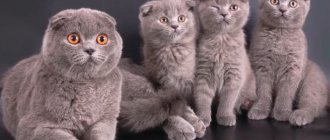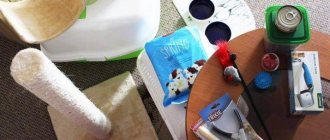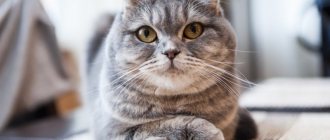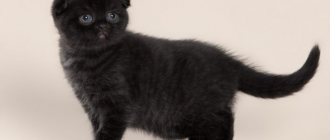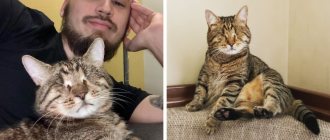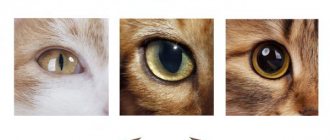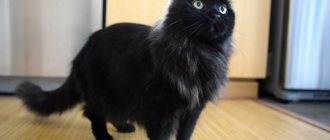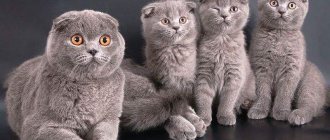Scottish Fold cats have fans all over the world: their small, downturned ears leave no one indifferent. But, unfortunately, it is precisely because of this feature that Scottish Folds are susceptible to osteochondrodysplasia. We will find out what this disease is, how it manifests itself, and we will also look at how to care for a sick cat, what to feed and how to treat it.
Description of the disease
Osteochondrodysplasia in cats (OCD or osteochondrodystrophy) is a genetic malformation of bones and cartilage that leads to slower growth and deformation.
Interesting! Translated from Greek, “osteo” means “bone,” and “dysplasia” means “developmental disorder.”
Osteochondrodysplasia most often affects Scottish Folds, since the disease is directly related to the gene for fold ears. Scots' downturned ears remain this way due to insufficient cartilage formation and disruption of its formation. The lop ear gene is responsible not only for ear deformation, but also for disruption of cartilage formation throughout the body.
Chondrodysplasia usually affects cats' limbs, thoracic, lumbar and caudal vertebrae. This disease can also manifest itself in the form of achondroplasia. With this disease, the cat’s paws cannot grow to normal size, so the pet develops dwarfism.
Osteochondrodysplasia is not life-threatening in most cases, but it can significantly reduce the quality and duration of life.
Eye diseases
Kittens of this Scottish breed especially often have watery eyes. There are two reasons for this: either it is a consequence of an infection, or the reason is the special structure of the skull. In adult cats, cataracts and glaucoma mainly appear, which can subsequently lead to complete loss of vision.
Glaucoma is an increase in intraocular pressure, accompanied by an enlargement of the eyeball. Cataracts in cats are characterized by clouding of the lens. Often these diseases are asymptomatic. Therefore, it is important for cats of this breed to undergo regular examination by a doctor.
Causes
Osteochondrodysplasia in cats is inherited. Its manifestation is not related to the gender of the animal.
OCD is considered a disease of Scottish Fold cats, because they are the owners of a mutant gene for fold ears. To avoid the appearance of offspring with osteochondrodysplasia, breeders always cross fold-eared cats with straight-eared cats. In this case, the risk of a dangerous gene appearing is minimal. However, in rare cases, even crossing a straight with a fold may result in a kitten with osteochondrodysplasia. That is why in some countries it is prohibited to breed Scottish Fold cats.
In Scottish Folds, the disease varies in severity. The most common disorders are the development of the bone skeleton, but in the most severe situations, deformation of the limbs can develop.
What ailments are there?
Diseases significantly shorten the life of fold-eared cats, so they may not live long depending on the disease. The most common:
- Osteochondrodysplasia. Characterized by skeletal deformation. Highland Fold and Scottish Fold breeds are at high risk of getting the disease. Straight-eared people are less susceptible. Proper treatment and care stops the disease and the cat can live to an old age.
- Hemophilia types A and B. Characterized by a blood clotting disorder and prolonged bleeding at the site of even a small cut. How many years Scottish cats with this diagnosis live depends on other anomalies of the body, since internal bleeding leads to rapid death.
- Eye diseases. A fold-eared or straight-eared cat often suffers from eversion or inversion of the eyelids, which provokes conjunctivitis, keratitis or blepharitis. Eye diseases do not affect a cat’s life expectancy if you consult a veterinarian in a timely manner and stop the inflammation.
- Ear ailments. The most common are otitis media, deafness and tumors due to the abnormal structure of the hearing organ. With proper care, your cat will live a long time. However, if the neoplasm is malignant, metastases may form and life expectancy will be significantly reduced.
- Deterioration of immunity. Pedigree cats have reduced body defenses, so they are susceptible to viral and bacterial diseases. Serious diseases (panleukopenia, rhinotracheitis) can “take away” your pet much earlier than expected.
- Metabolic disease. Spayed and neutered pets who suffer from hormonal imbalance suffer the most. This leads to obesity or diabetes.
Clinical symptoms
Unfortunately, owners notice signs of osteochondrodysplasia in their pet only when they become pronounced. Main clinical symptoms of the disease:
- lameness;
- head too big;
- crooked teeth;
- stiff gait;
- jaw protruding forward;
- excessively short and flattened nose;
- the appearance of growths on the paws;
- refusal to move and jump;
- the tail is too short and inactive;
- pain during movement;
- twisted and shortened limbs;
- walking on bent legs.
- The base of the tail is too thin.
Important! Osteochondrodysplasia of Scottish Fold cats most often appears at the age of 1.5–2 months. If the gait of a small Scottish Fold is stiff and the tail is motionless, then the kitten is not recommended for purchase.
Ear diseases
As already mentioned, an altered gene responsible for the structure of a cat’s ear often leads not only to a change in the shape of the auricle. Thus, lop ears are often accompanied by deafness or hearing impairment.
Because the shape of the ear is not what it should naturally be, this leads to the accumulation of dirt and infections of the outer or inner ear. For example, diseases of the outer ear are more common. These are a variety of otitis media and tumors of the ear canals.
Symptoms of ear diseases in cats include ear discharge, odors, ear skin irritation, and head shaking.
Osteochondrodysplasia is an incurable disease. Scottish fold cats are at risk. Learn about the causes and methods of preventing the disease.
Diagnostic methods
Diagnosis of osteochondrodysplasia in Scottish cats is carried out on the basis of a visual examination, as well as a study of the animal’s pedigree. In addition, to make a final diagnosis, the veterinarian will prescribe the following tests:
- General and biochemical blood test.
- General and biochemical urine analysis.
- X-ray examination of the limbs, spine and tail.
In the image of a cat with osteochondrodysplasia, you can see the deformation of the skeleton, and in the area of the limbs you can detect growths around the joints, while the gaps between them are very narrow. In severe cases of the disease, cartilage tissue is absent, and the vertebrae in the lumbar and caudal regions grow together.
What is bone exostosis
Osteochondral exostosis is a benign osteochondral formation on the outer surface of the bone. Most often, it is detected at a young age before the end of skeletal growth, including in children.
The formation of osteochondroma provokes a disruption of the natural processes of resorption (resorption) and the formation of new bone tissue (remodeling).
Exostosis is a growth formed by spongy bone and having a cortical layer (a strong, hard “shell”). It can grow on a stalk or be attached to a bone with a wide base. On the outside, the bone growth is covered with cartilage tissue, which has much in common with articular cartilage. Its thickness does not exceed 1 cm. The top layer of exostosis is also called a cartilaginous cap.
Osteochondroma is a consequence of impaired bone growth in the area of the epiphyseal plates, i.e., their displacement from the anatomically correct position with the “throwout” of cartilage tissue to the side. Subsequently, just like the metaphysis, it ossifies in the direction from the base to the apex, which leads to the formation of bone exostosis with a cartilaginous cap. At the same time, it continues to increase in size until the growth zones close, and can appear in absolutely any bone. The bony part of osteochondroma is formed from unevenly distributed bone beams. Between them there is adipose tissue with islets of hematopoiesis. Bone septa are formed due to enchondral ossification of cartilage. This raises the possibility of the presence of calcifications in the cancellous bone.
The metaphyseal areas of long tubular bones are most often affected:
- femoral (30%);
- shoulder (10-20%);
- tibial (15-20%).
Metaphysis (sometimes neck) is a small part of a tubular bone that is located between its epiphysis (head) and diaphysis (body). At 18-25 years of age, it stops growing and ossifies, which indicates the completion of bone formation.
Thus, articular exostosis is often observed - the formation of a growth on the upper (proximal) part of the tibia or lower (distal) part of the femur, i.e. the tumor is localized just below or just above the knee. Damage to flat bones, i.e. exostosis of the rib, scapula, pelvic bones, are less common. Osteochondromas of the bones of the fingers, toes, and clavicle are diagnosed even less frequently. The most rare occurrence is the formation of bone growths in the spine.
Also, bone exostosis can form on the lingual or buccal surface of the jaw. At the same time, it can take the form of a ridge, protrusion, mound, or take on bizarre shapes. In such cases, patients are advised to consult a dentist.
Treatment
Unfortunately, there is no treatment that would permanently rid a Scottish Fold cat of osteochondrodysplasia. Typically, sick animals are given supportive care to improve their quality of life.
At the initial stage of osteochondrodysplasia, Scottish Folds are usually treated with non-steroidal anti-inflammatory drugs (Ainil, Ketoline, Meloxivet) and chondroprotectors (usually chondroitin sulfate or glucosamine). Such medications stop the destruction of cartilage tissue and increase the amount of joint fluid.
Also, as support for sick pets, manual therapy in combination with massage is prescribed. These procedures improve blood circulation in the animal’s limbs and also help preserve the structure of cartilage tissue. True, they should only be performed by a highly qualified specialist.
In the most severe cases, it may even lead to surgical intervention. Typically, Scottish Fold cats with osteochondrodysplasia undergo the following operations, which give good results:
- Osteotomy. Helps eliminate deformation and improve the performance of the musculoskeletal system, remove growths on bone tissue. For osteotomy, one has to resort to artificially breaking the bones and then connecting them in the required form.
- Arthrodesis. The joint is fixed in an optimal position, after which it gradually ossifies. Mobility in the joint is lost forever, but the support ability of the limb is preserved. Arthrodesis is usually performed if the cat is unable to move or put weight on the affected limb due to severe pain.
Interesting! In Japan and Europe, radiation therapy is used to treat cats with osteochondrodysplasia. It helps reduce pain and slow down the destruction of joints. This method is very effective, but due to the too high cost and lack of necessary equipment in Russian veterinary clinics, it is not yet available.
Exostosis in a child
It is in children that osteochondroma is most often first diagnosed, which is due to its formation from cells of the epiphyseal plate that is present only until the end of the growth period, which is adjacent to the metaphysis. It is also called the bone growth zone, since it is a hyaline cartilage whose cells are in constant miotic division. As a result, new chondrocytes (cartilaginous tissue cells) are formed, forming the epiphyseal plate, and the old ones are shifted to the metaphysis and subsequently replaced by osteoblasts (bone tissue cells).
In infants, violation of the rules for the prevention of rickets, in particular excessive use of vitamin D preparations, increases the likelihood of the formation of exostoses.
After puberty, the growth plates gradually close and are replaced by bone tissue, transforming into a thin epiphyseal line. If hormonal imbalances occur during this period, it is possible that the growth zones may remain open, which creates the preconditions for the formation of osteochondromas.
Usually, until the age of 7-8 years, bone exostosis does not manifest itself in any way in a child and makes itself felt only during the period of intensive growth, i.e., at 8-16 years, since it also begins to grow actively. In young children, such growths are present in the metaphysis area immediately near the epiphyseal plate, but subsequently move away from it and approach the diaphysis. Therefore, by how far the bone exostosis in children is from the epiphysis, the time of its formation is determined.
The growth of the neoplasm continues until the end of the growth period.
How to feed sick animals
To improve the quality of life of a Scottish Fold cat with OCD, owners should make their pet’s diet as balanced as possible. It should also contain additives that would help prevent fractures and reduce the rate of cartilage destruction. A Scottish fold cat with osteochondrodysplasia can be fed both natural food and ready-made food, but veterinarians still prefer the first option.
When choosing commercial food, owners need to pay attention to ensure that it is enriched with calcium, phosphorus, iodine, iron, and vitamins E and B. You can also purchase food for your pets that was specially designed for cats with sore joints. Manufacturers additionally introduce glucosamine and chondroitin into them, which, when used in combination, enhance each other’s effects.
When eating a natural diet, it is imperative to include raw meat, sinew and cartilage in the Scots diet.
Important! There is a misconception that Scottish Folds with OCD need to be given jellied meat. However, when boiled, the required amount of nutrients does not remain in the meat and cartilage. In addition, some of them are poorly absorbed by the cat’s body after prolonged cooking.
Owners of sick cats need to remember that such animals are prone to obesity due to a sedentary lifestyle. That is why you will have to constantly monitor the calorie content of the food your pet eats, as well as your pet’s weight, and weigh it regularly. If your cat is overweight, you need to work with your veterinarian to choose a diet for her, because obesity is dangerous not only for the musculoskeletal system, but also for the cardiovascular system.
Prevention measures
Hip dysplasia is an inherited disease. Cats with a history of dysplasia in their pedigree should not be allowed to be bred. If it is assumed that the kitten will participate in breeding, an in-depth analysis of its pedigree is necessary.
If your pet has a hereditary predisposition to articular dysplasia, it is important to carefully monitor his lifestyle. This will help reduce the risk of disease to a minimum.
- It is very important to adjust the animal’s diet by eliminating excess fats and carbohydrates. Food should be moderate in calories and contain sufficient minerals.
- It is necessary to monitor the cat's weight to prevent obesity.
- Regular veterinary examinations should not be neglected.
- It is necessary to provide the animal with the opportunity to move as much as possible and play active games.
It is in our hands to make sure that pets can always feel the joy of active movement. You just need to be a little more attentive to them so as not to waste time, and start treatment as early as possible.
Life expectancy of cats with OCD
Of course, all owners of Scottish fold cats with osteochondrodysplasia are concerned about the life expectancy of a pet with such a disease. Fortunately, the disease does not directly affect life expectancy. When the first symptoms of OCD appear, owners should take their cat to the doctor as soon as possible. After all, timely treatment can slow down the progression of the disease and improve the pet’s quality of life.
Some veterinarians suggest that owners euthanize a sick pet or amputate the affected limb. However, with good care, supportive care and patience on the part of the owner, the condition of the Scottish Fold cat can be significantly improved. You can also increase your pet's lifespan with a balanced diet.
Unfortunately, if the disease is too severe, it is still better for the animal to undergo euthanasia. It is suggested to do it if the disease is constantly progressing, the pet does not get up at all and does not go to the litter box, and he also has to take pills that no longer bring relief. In such a situation, it is better to stop the cat’s suffering, but the decision always remains with the owner.
Health
Most cats of this breed have excellent health, good immunity and endurance. But there are many disorders and diseases characteristic of British fold cats.
The cause of the majority of cases of genetic diseases in these animals is an altered gene that is responsible for the formation of ears.
1 Osteochondrodystrophy. The most common disease affecting fold-eared cats is osteochondrodystrophy. This is a genetic disorder that leads to skeletal deformities and causes osteoarthritis. The main deformations are a thickened, motionless tail, deformed, crooked paws.
Shortening of the limbs and tail is also characteristic. In addition to appearance, the presence of the disease is indicated by the behavior and movements of the cat. A sick animal does not jump, moves little, walks without bending its paws.
Osteochondrodystrophy is caused by impaired development of cartilage. This disease occurs when two fold-eared cats are crossed, and also in large dogs.
Experts recommend stopping the breeding of fold cats, as well as limiting the breeding of shorthaired Scottish cats due to the manifestations of this disease. There is no cure for this condition. Often leads to complete paralysis and suffering of animals.
2 Another serious disease characteristic of Scottish fold cats is hemophilia type B. It is expressed in the fact that during injuries and operations, the blood in wounds or incisions does not clot.
In other words, it is bleeding. The crust that forms on the wound consists mostly of fibrin. If an animal has hemophilia, there is not enough fibrin in the blood, so after the platelet plug disappears, bleeding resumes.
3 Other diseases that fold-eared cats are prone to are divided into:
- ophthalmic;
- ear;
- skin;
- diseases of internal organs;
- dental diseases.
Do straight-eared Scottish cats get sick?
Owners of the straight-eared variety of Scottish cats do not have to worry about the fact that their pets may develop osteochondrodysplasia. Scottish Straights are not susceptible to this disease, because their ears are not deformed, which means they do not have the gene for lop ears. In very rare cases, Scottish Straight cats may also experience deformation of the musculoskeletal system, but this is usually minor. This is because the Scottish cat breed is prone to various bone and joint problems.
Interesting! In addition to the Scots, representatives of the Ukrainian Levkoy breed are also susceptible to osteochondrodysplasia, since Scottish Folds were used to breed them.
Owners of Scottish Fold cats who have been diagnosed with osteochondrodysplasia should not despair. After all, with timely treatment, proper care, supportive therapy, as well as love and care from the owner, the pet can live a long and happy life.


